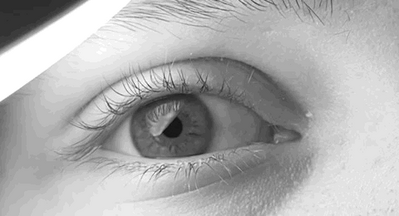Nystagmus
Original Editor - Lucinda hasmpton
Top Contributors - Lucinda hampton, Kim Jackson, Alyssa Brooks-Wells and Uchechukwu Chukwuemeka
Introduction[edit | edit source]
Nystagmus refers to rapid, involuntary movements that may cause one or both eyes to move from side to side, up and down, or rotate.[1] The nystagmus may be defined by the type of movement observed:
- Jerk nystagmus: a slow beat in one direction and a fast beat in the other
- Pendular nystagmus: the same speed and amplitude in both directions
- Rotary nystagmus: rotational beat on the Z-Axis[2]
These movements can reduce vision, and affect depth perception, balance, and coordination[3]
Some underlying conditions which cause nystagmus can be treated, especially childhood cataracts and strabismus and there are therapies for some neurological conditions and otologic conditions[1].
Etiology[edit | edit source]
There are three categories of etiology of nystagmus:
- Physiological nystagmus, which includes optokinetic, vestibular, and end-point nystagmus, occurs naturally to maintain a clear and steady image of the environment
- Optokinetic nystagmus: a normal reflex that involuntarily occurs with looking at a repetitive moving pattern such as a moving field or trees. It entails a smooth pursuit to track an object and a saccadic jump to the next object repetitively and therefore is a jerk nystagmus
- Vestibular nystagmus: a normal reflex during self-rotation with or without visual input as the inner ear detects motion
- End-point nystagmus: a normal small amplitude jerk nystagmus with end range eccentric gaze[1]
- Infantile nystagmus usually develops by three months of age and the most common types include congenital and manifest latent nystagmus. It is characterized by a horizontal movement and has correlations with conditions such as albinism, congenital iris absence, underdeveloped optic nerves, or congenital cataracts.
- Congenital nystagmus often lessens with convergence or certain angles of gaze which may be used for future interventions
- Although there are theories, there are no definitive reasons proven for why infantile nystagmus occurs [1]
- Acquired nystagmus may develop later in life and entails a disturbance to any portions of the mechanisms controlling gaze stabilization such as:
- Visual system - diseases of this system may lead to nystagmus due to the loss of visual fixation
- Vestibular organ - diseases or dysfunction of this system leads to an imbalance causing mixed horizontal-torsional nystagmus, commonly associated with vertigo
- Central connections - diseases of the central nervous system and its connections to the vestibular system may cause up or down-beat, torsional, periodic alternating, and/or see-saw nystagmus.
- Side effects of drugs (sedatives, alcohol, anticonvulsants) may also produce gaze-evoked nystagmus[1]
Clinical Presentation[edit | edit source]
Symptoms and complaints may include:
- Blurred or jumpy vision - complaints of difficulty with reading or watching television
- Oscillopsia: the illusory sensation the stationary visual world is moving [1]
- Oscillopsia with head movement is indicative of abnormal vestibuloocular reflex (VOR)
- Dizziness
- Vertigo: a type of dizziness that is often described as feeling that you are spinning or that the world is spinning around you [4]
- Loss of balance
- Abnormal head posture -Some people find that their eye movements reduce in certain positions, and they may move their head to maintain this position. This can result in neck and shoulder problems[5].
Diagnosis[edit | edit source]
- When nystagmus is a new symptom and occurs with new dizziness or vertigo, the patient should get prompt medical attention.
- People experiencing pendular nystagmus for the first time should see a neurologist or neuro-ophthalmologist. Although it is not typically an emergency, pendular nystagmus should be assessed promptly.
- Depending on associated symptoms, the medical practitioner may:
- Order tests such as a brain MRI or blood tests to rule out a potentially dangerous cause e.g. stroke
- Perform an ocular exam
- Perform a vestibular exam
- The type and direction of the nystagmus may be indicative of the cause and help to diagnose individuals
Treatment[edit | edit source]
- Canalith Repositioning Maneuvers - if testing is positive for BPPV,repositioning maneuvers for the affected canal can be used by a trained practitioner to treat nystagmus and vertigo
- Vestibular Rehabilitation Therapy (VRT) - if testing is positive for vestibulopathy or inner ear pathology, VRT may be used to help restore balance and vision through central compensation [4]
- Surgery - In rare cases eye muscle surgery can be performed which reduces the extent of the eye movement
- Null point training - Vision may be improved through null point training, where an eye care professional works with the person to train their eyes in the direction where vision is the clearest
- Magnifier - the use of a magnifier will enlarge print which can make it easier to read.
- Postural - changes can be made to allow for viewing positions that reduce the nystagmus. e.g. bringing reading material closer[5].
- Medications - various drugs are being used to manage the condition. Botulinum toxin injections have been shown to help some people with the acquired form of nystagmus (not usually effective in people with congenital nystagmus). The drugs gabapentin, baclofen and memantine have also proved to have some success at reducing the effects of acquired nystagmus in some people and they are also being trialed for people with congenital nystagmus. They do not work for everyone and can have unpleasant side effects.
- Various alternative therapies have been tried by people with nystagmus and, although there is no robust clinical or scientific evidence that they work, some people say they have led to improved vision.
- These include vision therapy, acupuncture, cranial osteopathy, and Alexander Technique.
- Relaxation techniques, meditation, Yoga, Pilates, and/or Tai Chi can help indirectly by reducing stress and helping people to stay calm. It has been found that, with both congenital and acquired nystagmus, the calmer and more rested a person is, the less the impact of their nystagmus on their sight and general well-being. People with acquired nystagmus also find that the worst effects of oscillopsia are alleviated if they are free from anxiety, fatigue and stress.[6]
References[edit | edit source]
- ↑ 1.0 1.1 1.2 1.3 1.4 1.5 Abadi RV. Mechanisms underlying nystagmus. J R Soc Med. 2002;95(5):231-4.
- ↑ Vision rehab OT The Functional Effects of Nystagmus Available:https://visionrehabot.com/the-functional-effects-of-nystagmus/ (accessed 5.9.2021)
- ↑ Sekhon RK, Deibel JP. Nystagmus Types.2019 Available:https://www.statpearls.com/articlelibrary/viewarticle/43058/ (accessed 5.9.2021)
- ↑ 4.0 4.1 Health Direct Vertigo Available:https://www.healthdirect.gov.au/vertigo (accessed 15.11.2023)
- ↑ 5.0 5.1 Vision Australia Nystagmus Available:https://www.visionaustralia.org/information/eye-conditions/nystagmus (accessed 5.9.2021)
- ↑ Nystagmus network Treatment Available:https://nystagmusnetwork.org/information/treatment/ (accessed 5.9.2021)








